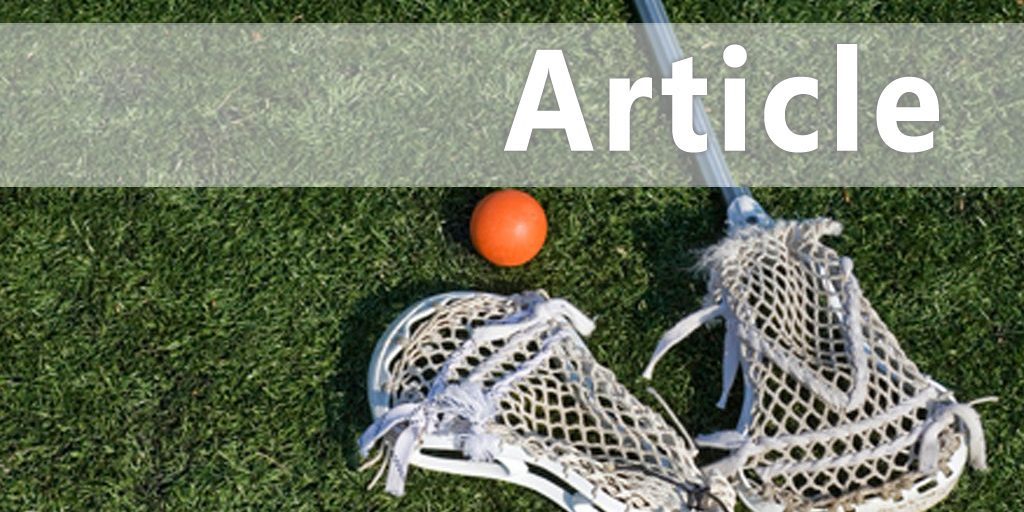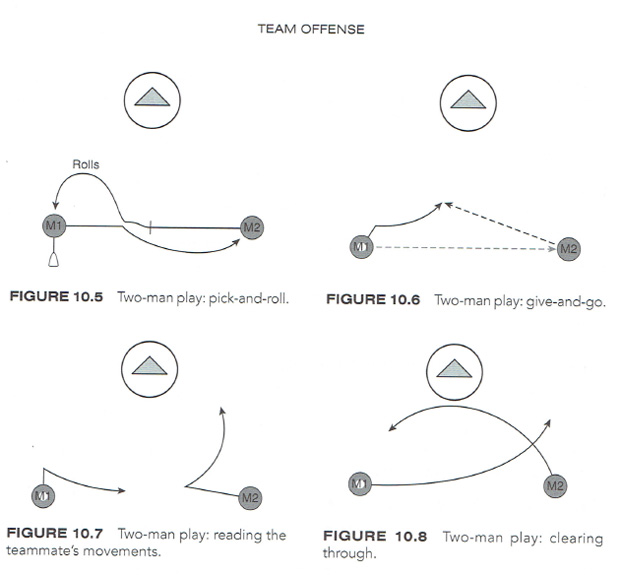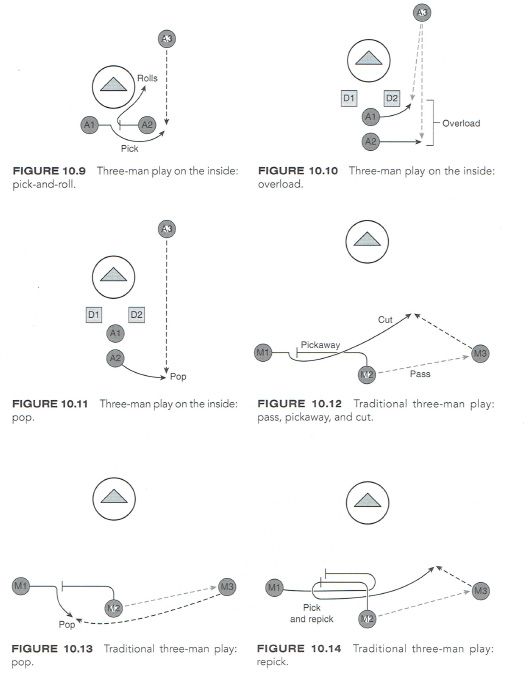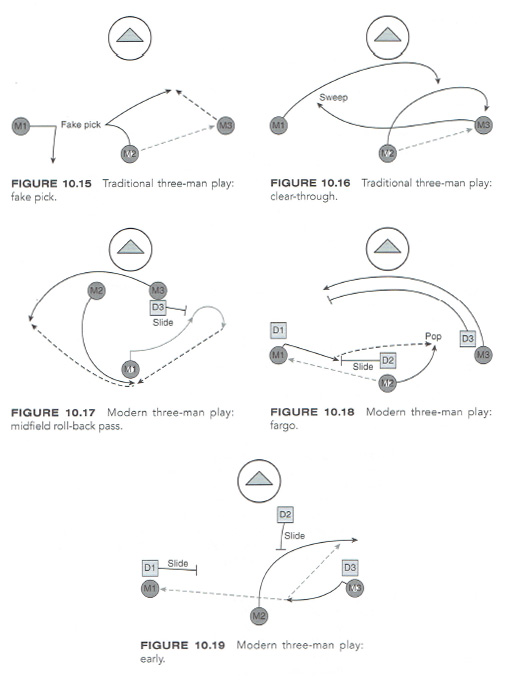| Team Offensive Play |
| By: Don Zimmerman and Peter England
Originally Published in: Men's Lacrosse Provided by: Human Kinetics Two-Man Plays Basic team offense starts with two-man plays. The purpose of two-man plays is for two offensive players to act in a synchronized manner to create an advantage against the defense. This advantage can be created by the confusion of a pick or the surprise of a give-and-go. Also, this advantage can be maximized if the offensive player reads his teammate's movements and clears through for the ball carrier, thereby minimizing the opportunity for one defender to play two offensive players. Pick-and-Roll Midfielder 1 has the ball at position 5, and midfielder 2 is at position 3. Midfielder 2 cuts left and sets a pick; midfielder 1 dodges over this pick. Midfielder 2 then rolls back for an outlet pass (see figure 10.5). Give-and-Go Midfielder 1 has the ball at position 5, and midfielder 2 is at position 3. Midfielder 1 throws the ball to midfielder 2 and quickly cuts right, looking for a return pass from midfielder 2 (see figure 10.6). Reading the Teammate's Movements Midfielder 1 has the ball at position 5, and midfielder 2 is at position 3. Midfielder 1 uses a split dodge from left to right. Midfielder 2 moves left and then right to clear space for midfielder 1. Midfielder 2 mirrors midfielder 1's movement (see figure 10.7). Clearing Through Midfielder 1 has the ball at position 5, and midfielder 2 is at position 3. Midfielder 1 uses a right-handed sweep dodge across the front of the goal, while midfielder 2 cuts underneath midfielder 1 (see figure 10.8). Midfielder 2 wants to cut hard and occupy his defender instead of "drifting" underneath his teammate, midfielder 1. Midfielder 2 wants to open up the dodging area.
Three-Man Plays The basics of three-man plays are similar to the two-man plays: picking, faking a pick, clearing out, and so on. However, adding a third player to the tactical mix increases both the reward and the risks of the maneuver. The plays provide more offensive opportunities, but there are also more defenders involved who want to break up the play. Some three-man plays are designed for the inside, and some are geared for the perimeter. Three-Man Plays on the Inside A three-man play on the inside is a set play designed to feed the ball from the perimeter to the inside crease area. The two off-ball offensive players are setting various picks (pick, overload, and pop) to get each other open, and the ball carrier behind the goal wants to feed the ball to the crease. The purpose of this progression is to get a high-quality shot from the crease. Pick-and-Roll Attackman 1 is on left crease, attackman 2 is on right crease, and attackman 3 has the ball at position 2. Attackman 2 cuts left and sets a pick for attackman 1. Attackman 1 cuts over the pick, looking for a feed from attackman 3 behind the goal. Attackman 2 rolls to the crease as a secondary target (see figure 10.9). Overload Attackman 1 is stationed low (nearer the crease), and attackman 2 is stationed higher (farther from the crease). They are in an I formation on the crease. Attackman 1 cuts low to the right, and attackman 2 cuts sideways to the right. Attackman 1 and attackman 2 overload one side of the crease (right side), and attackman 3 tries to feed the open cutter (see figure 10.10). Pop Attackman 1 and attackman 2 use the same I formation on the crease as in the previous overload play. Attackman 2 makes a high cut off of attackman 1 and pops off the crease (see figure 10.11). Three-Man Plays on the Perimeter Three-man plays on the perimeter are an offensive progression in which the unit tries to get an off-ball teammate open for an offensive opportunity-catch and shoot, catch and feed, and so on. If unsuccessful, the off-ball players then create space and clear out for the ball carrier. The three-man plays on the perimeter are either traditional or modern in style. Traditional Three-Man Plays The traditional three-man plays were prevalent from the 1960s through the 1990s. This offensive progression is based on five maneuvers: pick, pop, repick, fake pick, and clear-through. This progression is described here with a midfield unit in the midfield area. The five-play sequence can also be used with the attack unit and the ball starting out behind the goal. Pass, Pickaway, and Cut Midfielder 1 is at position 5, midfielder 2 has the ball at position 4, and midfielder 3 is at position 3. Midfielder 2 passes the ball to midfielder 3. Midfielder 2 then cuts to midfielder 1 and sets a pickaway for midfielder 1. Midfielder 1 cuts over the pick for a pass from midfielder 3 (see figure 10.12). Pop The players use the same setup as for the "pass, pick away, and cut." Mid-fielder 2 passes the ball to midfielder 3. Midfielder 2 then cuts to midfielder 1 and sets a pick for midfielder 1. Midfielder 1 cuts to the pick and then pops out for a feed from midfielder 3 (see figure 10.13). Repick The players use the same setup and sequence as for the "pass, pick away, and cut." When midfielder 1 cuts over the pick (for a pass from midfielder 3) but is not open, he then sets a repick for midfielder 2. Midfielder 2 cuts over the repick for a pass from midfielder 3 (see figure 10.14).
Fake Pick The players use the same setup as for the "pass, pick away, and cut." Midfielder 2 passes the ball to midfielder 3. Midfielder 2 cuts toward midfielder 1 but fakes a pick and cuts back for a feed from midfielder 3 (see figure 10.15). Clear-Through The players use the same setup and sequence as for the "pass, pick away, and cut." Midfielder 2 passes the ball to midfielder 3, and they run the off-ball sequence; however, no one is open. Midfielder 1 and midfielder 2 then cut underneath midfielder 3, and midfielder 3 dodges to the left and sweeps across the front of the goal (see figure 10.16). Modern Three-Man Plays Modern three-man plays are a reaction to opposing defenses executing two strategies. First, defenses began to slide from the crease to the midfield ball carrier before he had a premium shot. Second, defenses began to take away the midfield ball carrier's outlet pass to X-behind. As a result, the ball carrier redirected the ball out front, looking for an opening. Midfield Roll-Back Pass The offense uses a 1-4-1 offensive set. Midfielder 2 and midfielder 3 are on the crease, and midfielder 1 is out top with the ball. Midfielder 1 executes a right-handed dodge to the goal, midfielder 3 cuts to position 4, and midfielder 2 cuts to position 5. If the defense slides from the crease to the dodging midfielder (1), then the offense has an advantage out top. Midfielder 1 throws a roll-back pass to midfielder 3 out top, and midfielder 3 feeds midfielder 2 for a shot (see figure 10.17). Fargo Fargo is used to take away the second defensive slide (midfielder 3 cuts through underneath). Midfielder 1 is at position 5. Midfielder 2 has the ball at position 4 and is covered by defender 2. Midfielder 3 is at position 3 and is covered by defender 3. Midfielder 3 cuts underneath to the crease, and defender 3 follows him inside. Midfielder 2 passes the ball to midfielder 1 and cuts toward position 3. Midfielder 1 catches the ball and makes a right-handed move toward the middle of the field, attacking defender 2. When defender 2 slides, midfielder 1 makes an outlet pass (a pop pass) to midfielder 2. There is no second slide to midfielder 2 (see figure 10.18). Early Early is used when the defense forces a ball carrier to the middle of the field and to his weak hand. Midfielder 1 is at position 5 and is covered by defender 1. Midfielder 2 is at position 4. Midfielder 3 is at position 3 and is covered by defender 3. Midfielder 3 has the ball and makes a left-handed move because defender 3 is forcing him into the middle of the field. Midfielder 2 clears through "early" and curls underneath to open up the middle of the field. When midfielder 2 curls underneath midfielder 3 and midfielder 3 is forced into the middle, the defense may want to switch. If the defense tries to switch, midfielder 3 throws the ball back to midfielder 2. If defender 1 slides, midfielder 3 passes to midfielder 1. If the defense slides from the crease, then midfielder 3 dumps the ball inside (see figure 10.19).
|










